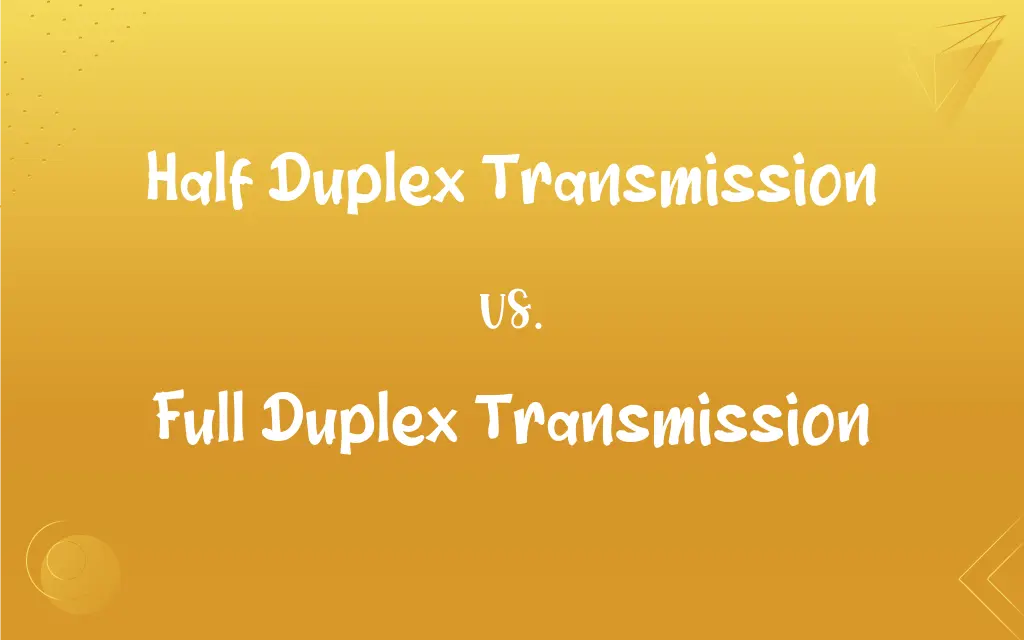Half Duplex Transmission vs. Full Duplex Transmission: What's the Difference?
Edited by Janet White || By Harlon Moss || Updated on October 26, 2023
Half duplex transmission allows communication in both directions, but not simultaneously, while full duplex transmission allows simultaneous two-way communication.

Key Differences
Half duplex transmission supports two-way communication, but data can flow in only one direction at a time. Full duplex transmission allows simultaneous two-way data flow.
In half duplex transmission, a device must wait for the other to finish transmitting before responding. In full duplex transmission, both devices can send and receive at the same time.
Half duplex transmission is like a walkie-talkie, where only one person speaks at a time. Full duplex transmission is akin to a telephone conversation, with both parties speaking and listening simultaneously.
Half duplex transmission typically has lower bandwidth requirements. Full duplex transmission often requires more bandwidth for simultaneous communication.
In scenarios with limited bandwidth, half duplex transmission is more practical. For high-speed, real-time communication, full duplex transmission is preferable.
ADVERTISEMENT
Comparison Chart
Simultaneity
One direction at a time
Simultaneous two-way
Communication Style
Walkie-talkie style
Telephone conversation style
Bandwidth Requirement
Lower
Higher
Suitability
Limited bandwidth scenarios
High-speed, real-time needs
Example
CB radios
Fiber optic cables
ADVERTISEMENT
Half Duplex Transmission and Full Duplex Transmission Definitions
Half Duplex Transmission
Data flow in a single direction at once.
Half duplex transmission is used in certain security systems.
Full Duplex Transmission
Communication without interruption.
Full duplex transmission ensures uninterrupted video calls.
Half Duplex Transmission
Sequential sending and receiving.
Older network systems often relied on half duplex transmission.
Full Duplex Transmission
Data transmission and reception at the same time.
Full duplex transmission is essential for live streaming.
Half Duplex Transmission
One-way communication at a time.
Walkie-talkies use half duplex transmission.
Full Duplex Transmission
Parallel data flow in both directions.
Modern networks mostly use full duplex transmission.
Half Duplex Transmission
Alternating two-way communication.
Half duplex transmission is evident in CB radio use.
Full Duplex Transmission
Simultaneous two-way communication.
Smartphones use full duplex transmission.
Half Duplex Transmission
Communication with turn-taking.
Half duplex transmission resembles a polite conversation where each waits their turn.
Full Duplex Transmission
Continuous sending and receiving.
Full duplex transmission allows seamless conversations over the internet.
FAQs
Can half duplex devices talk and listen at the same time?
No, they can either talk or listen, but not both simultaneously.
Can full duplex transmission be used in telephony?
Yes, it's commonly used for seamless telephone conversations.
Can half duplex transmission lead to delays?
Yes, due to alternating communication, it can cause delays.
What is half duplex transmission?
It allows communication in one direction at a time.
Is half duplex transmission suitable for real-time applications?
It's less suitable compared to full duplex due to turn-taking in communication.
Are walkie-talkies an example of half duplex transmission?
Yes, they are a classic example of half duplex transmission.
Is full duplex transmission used in modern internet communication?
Yes, it's widely used in high-speed internet communication.
Does full duplex transmission improve conversation quality?
Yes, it allows for more natural and uninterrupted conversations.
Is half duplex transmission outdated?
It's less common but still used in specific scenarios like radio communication.
Do security systems use half duplex transmission?
Some do, especially in scenarios with limited bandwidth.
Are fiber optic cables used for full duplex transmission?
Yes, they're commonly used for high-speed full duplex communication.
Is half duplex transmission cheaper to implement?
Generally, it can be less expensive due to simpler technology.
Does full duplex transmission require special hardware?
Yes, it often requires more sophisticated hardware for simultaneous transmission.
Can half duplex transmission cause data collisions?
Yes, if two devices attempt to transmit simultaneously.
What is full duplex transmission?
It enables simultaneous two-way communication.
Is full duplex transmission essential for live streaming?
Yes, it ensures continuous data flow necessary for streaming.
How does half duplex transmission affect network performance?
It can limit performance due to the alternating nature of communication.
Is full duplex transmission better for online gaming?
Yes, it provides the necessary speed and simultaneity for smooth gaming.
Do full duplex systems require more bandwidth?
Yes, they typically require more bandwidth for simultaneous communication.
Can full duplex systems transmit data over long distances?
Yes, especially with technologies like fiber optics.
About Author
Written by
Harlon MossHarlon is a seasoned quality moderator and accomplished content writer for Difference Wiki. An alumnus of the prestigious University of California, he earned his degree in Computer Science. Leveraging his academic background, Harlon brings a meticulous and informed perspective to his work, ensuring content accuracy and excellence.
Edited by
Janet WhiteJanet White has been an esteemed writer and blogger for Difference Wiki. Holding a Master's degree in Science and Medical Journalism from the prestigious Boston University, she has consistently demonstrated her expertise and passion for her field. When she's not immersed in her work, Janet relishes her time exercising, delving into a good book, and cherishing moments with friends and family.































































